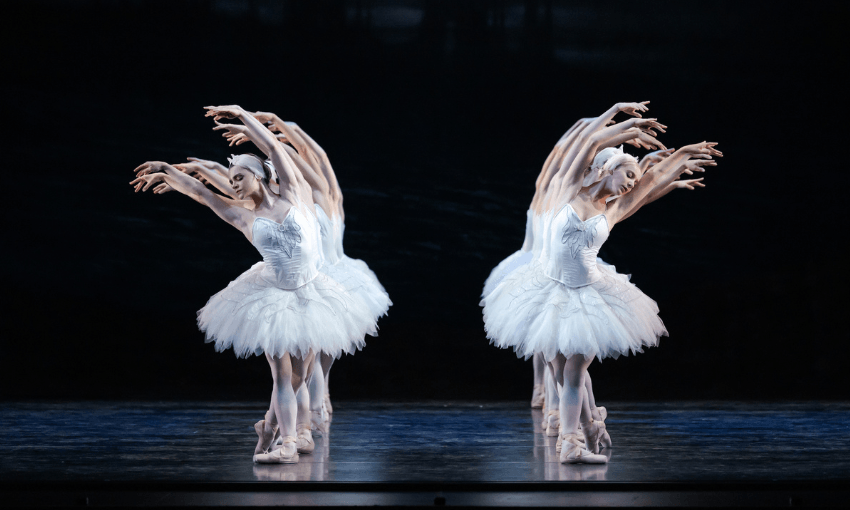The Royal New Zealand Ballet is performing Swan Lake around the country. What kind of dream does the ballet sell?
Before going to see the Royal New Zealand Ballet perform Swan Lake, I had about as much familiarity with the plot of this ballet as could be expected from having watched most of Black Swan before getting too scared, and knowing the title. (There are swans… and there’s a lake!). Luckily, with a Wikipedia skim of the story before going to the show at Auckland’s Aotea Centre on a cold Thursday night, I knew enough of the story to enjoy the music and the dancing without worrying about whether a particular angle of the hand or trill from a trumpet conveyed an essential part of the narrative.
Attending a ballet performance as someone who has never done any dance classes is quite relaxing, because not a single part of me was wondering if I could do it myself. As I watched, phrases started floating to the surface of my mind: jeté, pas de deux. One way or another, ballet lexicon has wormed its way into my cultural consciousness. As an art form, I’d place it somewhere between the athleticism of gymnastics, the playful showing-off characteristic of musicians and the surprise of theatre: these are real people interacting on stage, using their bodies to tell a story.
Of course, ballet is a very European artform, and the continued existence of this art at the level of the RNZB requires a great deal of government funding and private donations, in order for the dozens of people on and offstage to make the Swan Lake performance happen. It is extremely traditional ballet: elaborate costumes and sets, pale pink tights, arms moving in glorious synchrony with the dimensions of sound from the orchestra. The story itself draws on European folk tales of sorcerers, princes and darkly magical forests: frothy fantasy made muscular in the bodies of the dancers.
Mayu Tanigaito, as Odette, is incredible: airily jumping and twirling, making it look easy. I found myself looking for signs of strain: the slight ripple of her chest as she caught her breath after a particularly taxing sequence. Her solo parts were especially impressive, as well as her frenetic dancing as Odile, Odette’s evil double. Prince Siegfried, performed by Laurynas Vėjalis, is a perfect counterpart: cheerful if incurious about the commoners he, hmm, swans past in the first scene, his body overtaken with awe when he encounters the swans around the lake. I did find that the penultimate scene in the palace was much more compelling and dramatic than the actual final scene, but perhaps this is part of the tradition of the ballet.
But beyond the principal dancers, what really compelled me about Swan Lake was the way the production worked as a whole. There’s less glory in the corps de ballet, the dancers who must be perfectly synchronised as swans, or hold their bodies taut even as onlookers to a palace scene. Yet their working together is integral to the performance: as is the conductor, keeping time, the harpist plucking the strings at exactly the right moment, the people rearranging the sets in the interval, the lights that make the whole thing visible. At the performance, it’s easy to be amazed by what people can do, but also by what is possible in the collaboration of the many hundreds of hands that bring a performance alive.
There are camp elements – the swishy costumes, the hand signals asking “will you marry me” and “do you promise”, the ornate sets. Inside the pink pointe shoes are feet damaged by the demands placed on their toes, far more than most people can endure. The flap of a feathery tutu as its dancer hops, other leg hovering above, is as absurd as it is (I’m sure) difficult to accomplish. I like that we can pay to watch this absurdity swish and pirouette across the Aotea Centre stage.
So much of dancing is about aspiration: the appearance of effortlessness when doing something that is in fact very difficult, pushing the human body to its bendiest, bounciest limits and doing so in time to music. But while the flourishes of ballet are astonishing to look at, what I appreciated most about the performance was how it allowed space for imagination: how does it feel to be an unchosen swan, cursed just as much as Odette, but without attention from a prince? What does it tell me about the reality of power that costumes on a stage, angles of a shoulder, can so clearly tell me who’s in charge? And how does knowing that the society I live in allows the glossiness, frippery and raw, human energy of professional ballet to exist change the way I see the world outside the theatre? These aren’t questions I have straightforward answers to – but, like all kinds of art, I am glad that the ballet gave me an opportunity to think about them.



